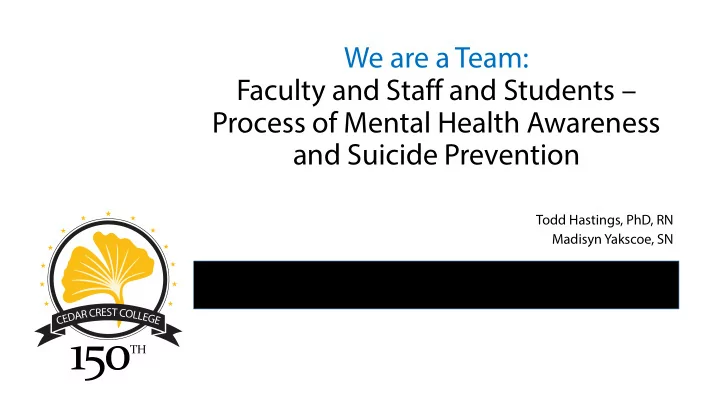

We are a Team: Faculty and Staff and Students – Process of Mental Health Awareness and Suicide Prevention Todd Hastings, PhD, RN Madisyn Yakscoe, SN
OBJECTIVES • Attendees will verbalize 2 concerns expressed by campus professionals (students, student services staff, and faculty) relative to mental health awareness needs; • Attendees will identify 2 strategies for improving mental health awareness on campus
Who we are: • Dr. Hastings is a faculty member at CCC (Nursing): • Education as a Psychiatric Clinical Nurse Specialist (like NP) • Conducts MHFA and QPR trainings on campus • Ms. Yakscoe is a student at CCC who • In HS was an officer with Best Buddies club • Has served as an FYE mentor (peer support) • Is the president of Active Minds on campus – is actively planning a cooperative suicide prevention walk • Is a member of the Students Nurses Association
Dr. Hastings and Ms. Yakscoe have no conflicts of interest or commercial support (e.g. pharmaceutical company or behavioral health companies).
Many of us in higher ed environments continue to share the concern and the challenge… Mental health concerns among students: • are escalating and overwhelming to our counseling centers – not new news but continues to be problematic • campus community is anxious about the anxiety ! • Solutions tend to be reactive or band aid approaches (i.e. hire more counselors – good but…)
BASIC CHALLENGES for us all…mental health awareness and suicide prevention • Staff have to stay within their role – limits and boundaries (the world we live in…liability; be mindful of FERPA) • Orientations for students only touch on the basics? – innovations such as suggested at this conference are needed! • On campus we cover in Res Life, but how well? This Photo by Unknown Author is licensed under CC BY • What about the non-traditional and commuters?
Plus we all tend to support each other, but work often without teaming up
What helps? TEAMWORK … what we all can do • Shared efforts to support greater awareness …leading to sensitivity on campus (discussions per targeted dialogue in meetings, workshops, awareness events); • Educational Interventions – a little bit goes a long way (brief but focused – link to tabling or other set ups in public spaces or distributed on-line); • Greater responsiveness …in a proactive and sustained way by all stakeholders within reasonable boundaries (student services for acute crisis, but what about responses to trends in a given academic year in support of just culture?)
Be proactive on campus: • Student services/counseling center at the forefront • Student groups (SGA) can support “awareness” , more…shared events • FACULTY SERVICE matters – beyond governance • Teamwork! HOW CAN WE MAKE A HEALTHIER CAMPUS CULTURE?
SPECIFICALLY: • SUPPORT your student services…what can we “do” within reasonable boundaries to HELP…KNOW HOW TO REFER • FOCUS themes ON CAMPUS – get active with ACTIVE MINDS • Tabling • Campus Events • Speaker forums – let human service discipline departments team up (psychology, social work, nursing, counseling, etc.) • Awareness events (we are teaming up with AFSP and another college in our region for campus walk events) • PARTNER for trainings (MHFA, QPR) • Student services – including Res Life, Mentoring and Peer Support • Academic advising – can be linked… • Be “supportive” through other like student groups AND campus centers (such as Diversity Center)
As we heard in our sessions… • We need motivated (not just tasked) individuals on campus (student services including campus centers – sure; but what about faculty and academic advising ) to support the discussions along with students • We need MORE BYSTANDER trainers (not same as gatekeepers on the service side, though “advisors” feel like gatekeepers at times) - how about faculty too? • Goal is to create an opportunity for faculty, staff, and students to share in supporting a safer and more just campus culture!
Academic ? Advising Student Affairs Student First and Engagement Second Year Experiences Residence Center for Life Diversity Health /Counseling Center CCC direct structure – pretty typical of many private colleges …and are great within their roles!
The focus is on our students! But modifying culture reaches over to staff, faculty and students…a just and sensitive culture! Lets take care of each other!
GET and keep the conversation started! Let’s talk about the response…the ways to help!
References Eisenberg, D., Downs, M. F., Golberstein, E., & Zivin, K. (2009). Stigma and help seeking for mental health among college students. Medical Care Research and Review , 66 (5), 522-541. Indelicato, N. A., Mirsu-Paun, A., & Griffin, W. D. (2011). Outcomes of a suicide prevention gatekeeper training on a university campus. Journal of College Student Development, 52(3), 350-361. Moutier, C., Norcross, W., Jong, P., Norman, M., Kirby, B., McGuire, T., & Zisook, S. (2012). The suicide prevention and depression awareness program at the University of California, San Diego School of Medicine. Academic medicine , 87 (3), 320- 326. Prince, J. P. (2015). University student counseling and mental health in the United States: Trends and challenges. Mental Health & Prevention , 3(1-2), 5-10. Turetsky, K. M., & Sanderson, C. A. (2018). Comparing educational interventions: Correcting misperceived norms improves college students’ mental health attitudes. Journal of Applied Social Psychology , 48(1), 46–55. https://doi- org.contentproxy.phoenix.edu/10.1111/jasp.12489 Van der Feltz-Cornelis, C. M., Sarchiapone, M., Postuvan, V., Volker, D., Roskar, S., Grum, A. T., ... & Ibelshäuser, A. (2011). Best practice elements of multilevel suicide prevention strategies. Crisis. Wood, M. (2012). The state of mental health on college campuses. Inquiry: The Journal of the Virginia Community Colleges , 17 (1), 5-15.
Recommend
More recommend